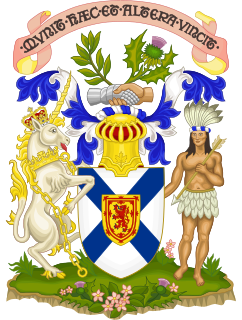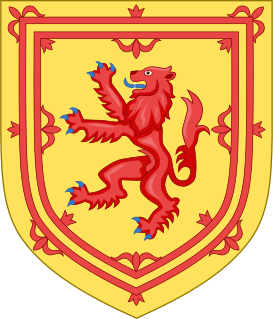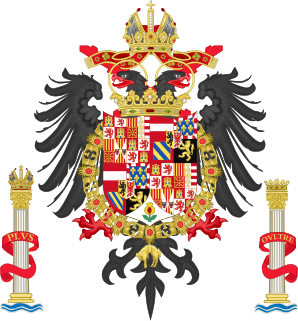
The coat of arms of Nova Scotia is the heraldic symbol representing the Canadian province of Nova Scotia. It is the oldest provincial achievement of arms in Canada, and the oldest British coat of arms in use outside Great Britain. It is blazoned as follows: Argent, a saltire azure charged with an escutcheon of the Royal Arms of Scotland.

The royal coat of arms of the United Kingdom, or the royal arms for short, is the arms of dominion of the British monarch, currently Queen Elizabeth II. These arms are used by the Queen in her official capacity as monarch of the United Kingdom. Variants of the royal arms are used by other members of the British royal family, by the British Government in connection with the administration and government of the country, and some courts and legislatures in a number of Commonwealth realms. A Scottish version of the royal arms is used in and for Scotland. The arms in banner form serve as basis for the monarch's official flag, the Royal Standard.

The coat of arms of Western Australia is the official coat of arms of the Australian state of Western Australia. It was granted by a royal warrant of Elizabeth II, Queen of Australia dated 17 March 1969.

The coat of arms of Quebec was adopted by order-in-council of the Government of Quebec on 9 December 1939, replacing the arms assigned by royal warrant of Queen Victoria on 26 May 1868.

The royal arms of England are the arms first adopted in a fixed form at the start of the age of heraldry as personal arms by the Plantagenet kings who ruled England from 1154. In the popular mind they have come to symbolise the nation of England, although according to heraldic usage nations do not bear arms, only persons and corporations do. The blazon of the arms of Plantagenet is: Gules, three lions passant guardant in pale or armed and langued azure, signifying three identical gold lions with blue tongues and claws, walking past but facing the observer, arranged in a column on a red background. Although the tincture azure of tongue and claws is not cited in many blazons, they are historically a distinguishing feature of the arms of England. This coat, designed in the High Middle Ages, has been variously combined with those of the Kings of France, Scotland, a symbol of Ireland, the House of Nassau and the Kingdom of Hanover, according to dynastic and other political changes occurring in England, but has not altered since it took a fixed form in the reign of Richard I of England (1189–1199), the second Plantagenet king.

Three Crowns is the national emblem of Sweden, present in the coat of arms of Sweden, and composed of three yellow or gilded coronets ordered two above and one below, placed on a blue background. Similar designs are found on a number of other coats of arms or flags.

The Worshipful Company of Pewterers is one of the 110 Livery Companies of the City of London. It ranks 16th in the order of precedence of City Livery Companies and has existed since at least 1348. Like all the other City Livery Companies, the Worshipful Company of Pewterers has four main pillars of activity: Charitable endeavour, assistance to education, support for its trade and profession, and being a convivial and caring social community.

The coat of arms of Toronto, Ontario, Canada, was designed by Robert Watt, the Chief Herald of Canada at the time, for the City of Toronto after its amalgamation in 1998. The arms were granted by the Canadian Heraldic Authority on 11 January 1999.

The current coat of arms of Zimbabwe was adopted on 21 September 1981, one year and five months after the national flag was adopted. Previously the coat of arms of Zimbabwe was identical to the former coat of arms of Rhodesia.

The coat of arms of Ireland is blazoned as Azure a harp Or, stringed Argent. These arms have long been Ireland's heraldic emblem. References to them as being the arms of the king of Ireland can be found as early as the 13th century. These arms were adopted by Henry VIII of England when he ended the period of Lordship of Ireland and declared Ireland to be a kingdom again in 1541. When the crowns of England, Scotland and Ireland were united in 1603, they were integrated into the unified royal coat of arms of kingdoms of England, Scotland and Ireland. The harp was adopted as the emblem of the Irish Free State when it separated from the United Kingdom in 1922. They were registered as the arms of Ireland with the Chief Herald of Ireland on 9 November 1945.

The royal arms of Scotland is the official coat of arms of the King of Scots first adopted in the 12th century. With the Union of the Crowns in 1603, James VI inherited the thrones of England and Ireland and thus his arms in Scotland were now quartered with the arms of England with an additional quarter for Ireland also added. Though the kingdoms of England and Scotland would share the same monarch, the distinction in heraldry used in both kingdoms was maintained. When the kingdoms of Scotland and England were united under the Acts of Union 1707 to form the Kingdom of Great Britain, no single arms were created, thereby maintaining the convention that the royal arms used in Scotland would continue to differ from those used elsewhere.

The coat of arms of Norfolk Island is the official symbol of the island and external Australian territory of Norfolk Island. It was granted by a Royal Warrant of Queen Elizabeth II on 20 October 1980.

The London County Council was granted a coat of arms in 1914 and a heraldic badge in 1956. The coat of arms can still be seen on buildings constructed by the council before its abolition in 1965.

The Coat of arms of West Yorkshire Metropolitan County Council was granted in 1975 to the new Metropolitan county council created in the previous year. The County Council was abolished in 1986 under the provisions of the Local Government Act 1985 and consequently the arms are no longer used. The current West Yorkshire Combined Authority uses a wordmark consisting of the authorities name.

Charles V, Holy Roman Emperor was the heir of several of Europe's leading royal houses. In 1506, he inherited the Burgundian Netherlands, which came from his paternal grandmother, Mary of Burgundy. In 1516, Charles became the king of Spain, inheriting the kingdoms first united by his maternal grandparents, Isabella I of Castile and Ferdinand II of Aragon. Finally, on the death of his paternal grandfather in 1519, Maximilian I, Holy Roman Emperor, he inherited the Habsburg lands in central Europe and was elected Holy Roman Emperor.

The coat of arms of the Extremadura is described in the Title I of the Spanish Law 4 of June 3, 1985, the Law of the coat of arms, flag and regional day of Extremadura.

The Coat of arms of Penang is largely based on the coat of arms of Penang first granted to the Settlement of Penang, then in the Federation of Malaya, by a Royal Warrant of King George VI dated 11 September 1949.
The coat of arms of the Orange River Colony was the official heraldic symbol of the Orange River Colony as a British colony from 1904 to 1910, and then of the Orange Free State province of South Africa from 1910 to 1925. It is now obsolete.

The coat of arms of Beverwijk is a coat of arms that has been renewed several times. The coat of arms of Beverwijk is the only coat of arms of a Dutch municipality that is surrounded by a cloak. This is highly unusual in the Netherlands, where such a cloak is normally reserved for nobility, the pope and national coats of arms.

The coat of arms of King's College London in London, England, are blazoned: on a Pale Azure between two Lions rampant respectant Gules an Anchor Gold ensigned by a Royal Crown proper on a Chief Argent an Ancient Lamp proper inflamed Gold between two Blazing Hearths also proper.






















